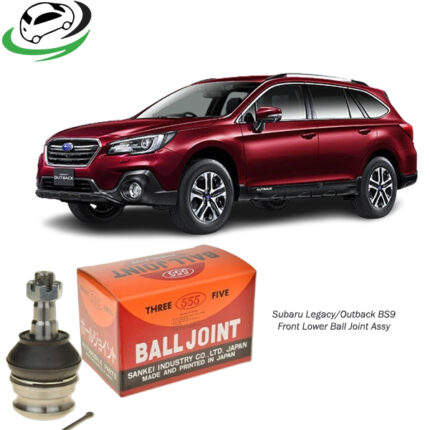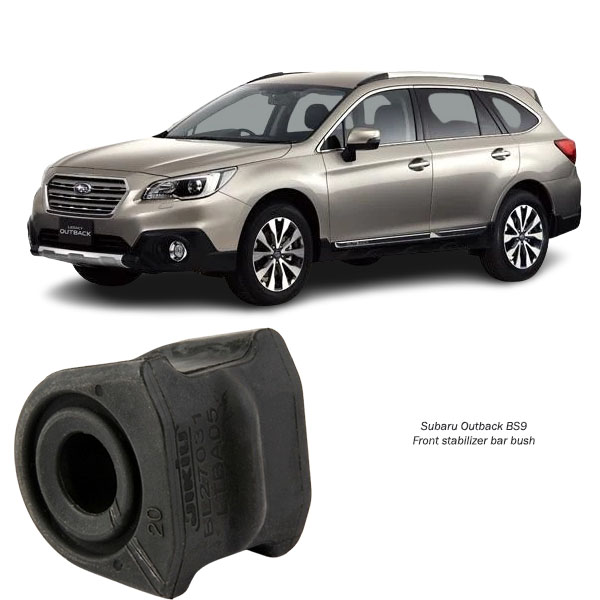-13%
Get Subaru Legacy/Outback BS9 Front stabilizer bar bush 20414-AL000 in Kenya
The front stabilizer bar bush is a crucial component in a vehicle’s suspension system. It works in conjunction with the stabilizer bar (also known as the anti-roll bar or sway bar) to provide improved handling, reduce body roll, and enhance the overall safety and stability of the vehicle. These small but vital parts often go unnoticed, but they play a significant role in the performance and comfort of your vehicle.
In this article, we will explore the function, importance, signs of wear, and replacement process for the front stabilizer bar bush. Understanding its role will help you appreciate the essential role it plays in your vehicle’s suspension system and how it contributes to driving comfort and safety.
What is a Front Stabilizer Bar Bush? 🔧
A stabilizer bar bush (or sway bar bush) is a small rubber or polyurethane component that acts as a cushion between the vehicle’s stabilizer bar and the vehicle’s chassis or suspension. The stabilizer bar itself is a metal rod that connects the left and right sides of the vehicle’s suspension system. It is designed to reduce the vehicle’s body roll during turns or when navigating uneven terrain.
The front stabilizer bar bush serves as the mount or support that holds the stabilizer bar in place, ensuring it operates correctly. It also absorbs the shocks and vibrations from the stabilizer bar during operation, preventing excessive wear and tear and helping to maintain the vehicle’s handling stability.
Function of the Front Stabilizer Bar Bush 🌟
The front stabilizer bar works by linking the left and right sides of the suspension, preventing excessive roll of the vehicle’s body. When a car takes a corner or goes through a sharp turn, centrifugal force pushes the body of the car outward. The stabilizer bar helps to reduce this body roll by transferring some of the force from one side of the vehicle to the other, keeping the body level and the vehicle stable.
The stabilizer bar bush plays an essential role in this process by performing the following functions:
-
Cushioning and Reducing Friction: The stabilizer bar bush absorbs the impact and vibration caused by the movement of the stabilizer bar during driving. By doing so, it helps prevent excessive friction between the bar and the vehicle’s suspension system.
-
Securing the Stabilizer Bar: The bush keeps the stabilizer bar properly aligned and securely mounted within the suspension system. Without the bush, the stabilizer bar would lack the stability needed to function effectively.
-
Improving Handling and Stability: The bush helps the stabilizer bar perform its role more efficiently by allowing the bar to move freely while absorbing shocks. This leads to enhanced handling and reduced body roll during turns.
-
Reducing Wear and Tear: The rubber or polyurethane material of the bush absorbs much of the stress placed on the stabilizer bar. This reduces wear on both the bush and the stabilizer bar, contributing to the longevity of the suspension system.
Types of Stabilizer Bar Bushes 🔄
There are primarily two types of materials used for front stabilizer bar bushes:
-
Rubber Bushes 🌱
-
Rubber is the most common material used for stabilizer bar bushes. It offers a balance between durability, flexibility, and noise reduction.
-
Advantages:
-
Absorbs shocks well.
-
Provides a quieter ride by reducing squeaking sounds.
-
Typically more affordable than polyurethane bushes.
-
-
Disadvantages:
-
May wear out faster compared to polyurethane.
-
Less effective at reducing high-performance handling compared to polyurethane.
-
-
-
Polyurethane Bushes 🛠️
-
Polyurethane bushes are a more durable and performance-oriented option, commonly found in sportier or high-performance vehicles.
-
Advantages:
-
Higher durability and resistance to wear.
-
More resistant to harsh weather conditions, oils, and chemicals.
-
Provides firmer handling and reduces body roll more effectively.
-
-
Disadvantages:
-
Can increase noise, vibration, and harshness (NVH), making the ride slightly less comfortable.
-
More expensive than rubber bushes.
-
-
Both materials have their advantages, so the choice depends on the type of vehicle and its use (performance vs. comfort). For standard daily drivers, rubber bushes may be sufficient, while performance cars may benefit from polyurethane bushes to enhance stability and handling.
Signs of Worn or Damaged Front Stabilizer Bar Bushes ⚠️
Over time, the front stabilizer bar bush will experience wear due to constant exposure to heat, road grime, and the stresses of driving. Worn or damaged bushes can significantly impact the vehicle’s handling and suspension performance. Here are some signs that your stabilizer bar bushes may need replacing:
-
Excessive Body Roll: If you notice more body roll when taking turns or corners, this could indicate that the stabilizer bar bushes are worn, preventing the bar from stabilizing the body properly.
-
Clunking or Knocking Noises: A common symptom of a damaged stabilizer bar bush is a clunking or knocking sound when going over bumps or during sharp turns. This noise is caused by the stabilizer bar rubbing against the suspension components due to the worn-out bush.
-
Poor Handling: When the stabilizer bar bush is damaged, the vehicle may experience poor handling and responsiveness. You may feel that the car sways more than usual during turns, or it may feel unstable when driving on uneven roads.
-
Visible Cracks or Damage: If you inspect the stabilizer bar bushes and notice visible cracks, splits, or signs of wear, they will need to be replaced. Rubber bushes tend to crack over time, especially in areas with extreme heat or cold.
-
Uneven Tire Wear: Worn stabilizer bar bushes can affect the alignment of the suspension, leading to uneven tire wear. If your tires are wearing more on one side or have a noticeable difference in tread depth, it might be due to issues with the stabilizer bar bushes.
Replacing the Front Stabilizer Bar Bush 🛠️
Replacing the front stabilizer bar bush is a relatively straightforward task, though it requires some mechanical know-how. Here’s a general guide on how to replace the bush:
Tools You’ll Need:
-
Jack and jack stands
-
Wrenches and sockets
-
Lubricant
-
Replacement stabilizer bar bushes
-
Torque wrench
Step-by-Step Process:
-
Lift the Vehicle: Use a jack to lift the front of the vehicle and place it securely on jack stands. Make sure the wheels are off the ground to provide adequate access to the suspension.
-
Remove the Wheels: Use a wrench to remove the lug nuts and take off the wheels. This will allow you to reach the suspension components.
-
Locate the Stabilizer Bar: Find the stabilizer bar under the vehicle. It is typically connected to both sides of the front suspension.
-
Remove the Old Bushes: Using the appropriate tools, remove the bolts securing the stabilizer bar bush to the vehicle’s suspension. Gently remove the old bushes, being careful not to damage any surrounding components.
-
Install the New Bushes: Place the new bushes in the correct position on the stabilizer bar. Make sure they are properly aligned and lubricate them with the recommended lubricant to ensure a secure and smooth fit.
-
Reattach the Stabilizer Bar: Secure the stabilizer bar with the bolts and tighten them according to the manufacturer’s recommended torque specifications.
-
Reinstall the Wheels: Put the wheels back on and tighten the lug nuts. Lower the vehicle back to the ground carefully.
-
Test the Vehicle: Once the replacement is complete, take the vehicle for a test drive. Check for any unusual sounds or changes in handling to ensure the new stabilizer bar bushes are functioning properly.
Conclusion 🎯
The front stabilizer bar bush plays a vital role in your vehicle’s suspension system by reducing body roll and improving handling. Over time, these bushes can wear out and lead to symptoms like increased body roll, poor handling, and even noise. Regular inspection and replacement of worn-out stabilizer bar bushes can greatly enhance the safety, performance, and comfort of your vehicle. Whether you choose rubber or polyurethane bushes, keeping your suspension in top shape is key to ensuring a smooth and stable ride.
Follow us on Facebook for more parts.



